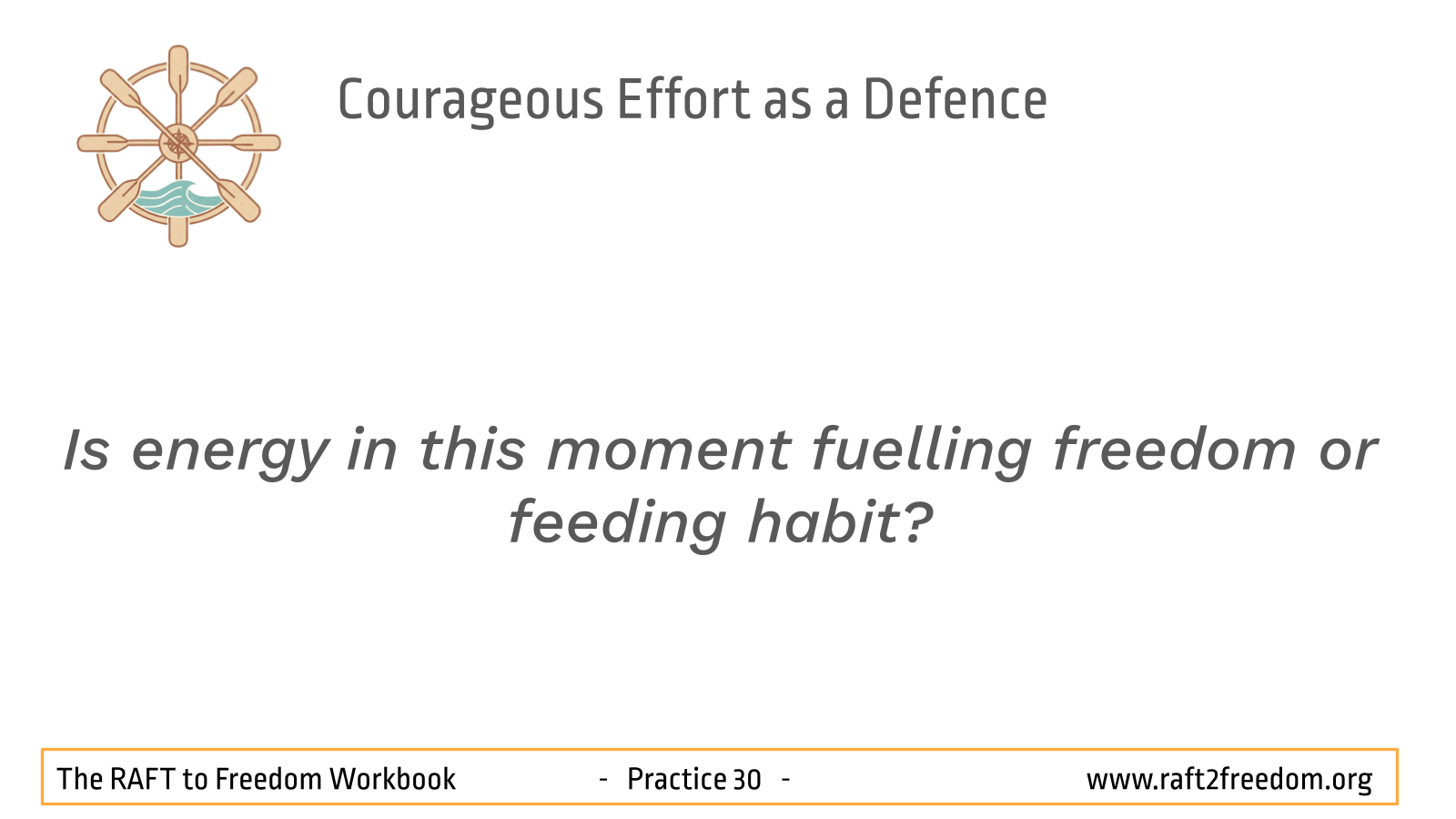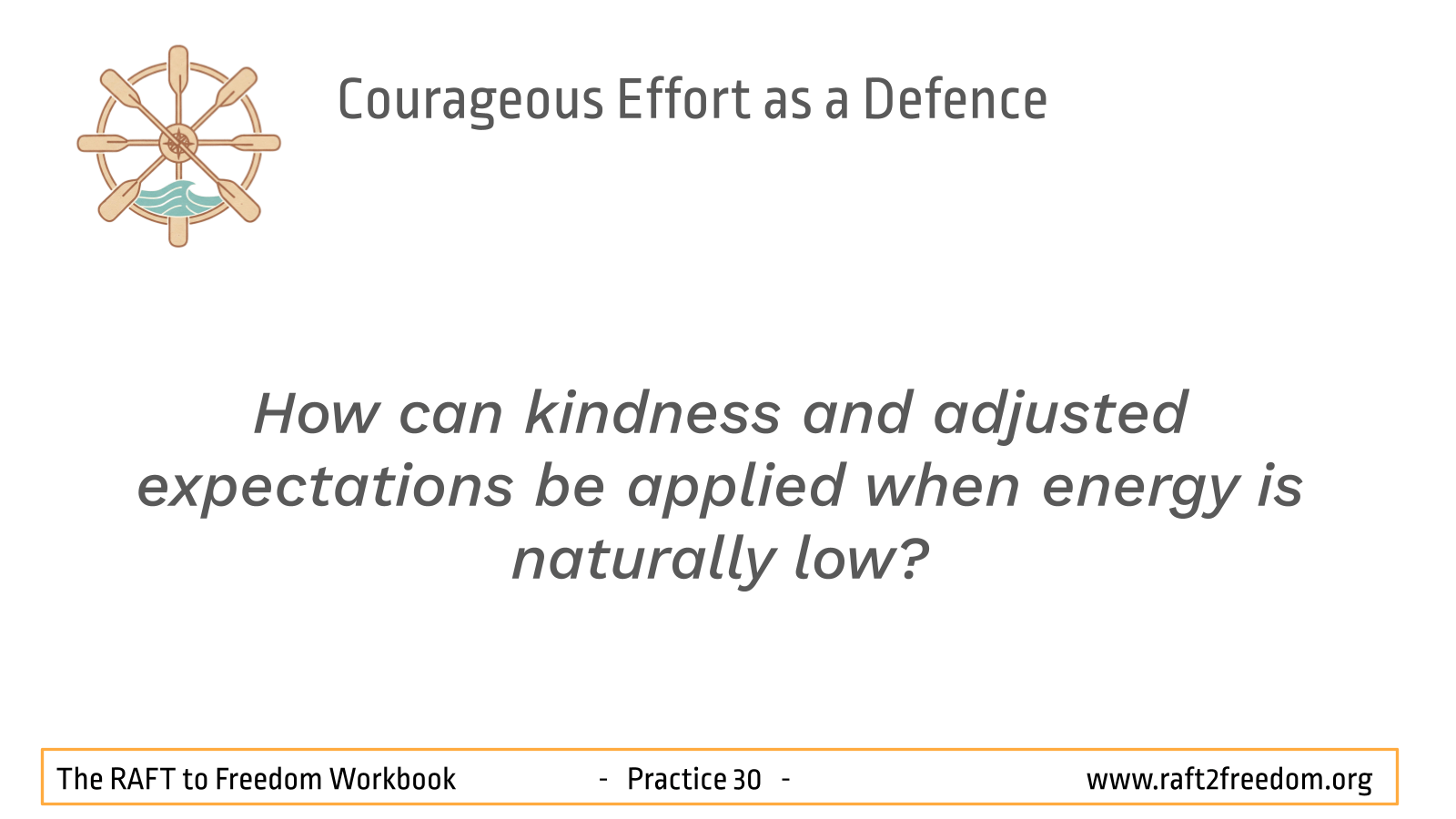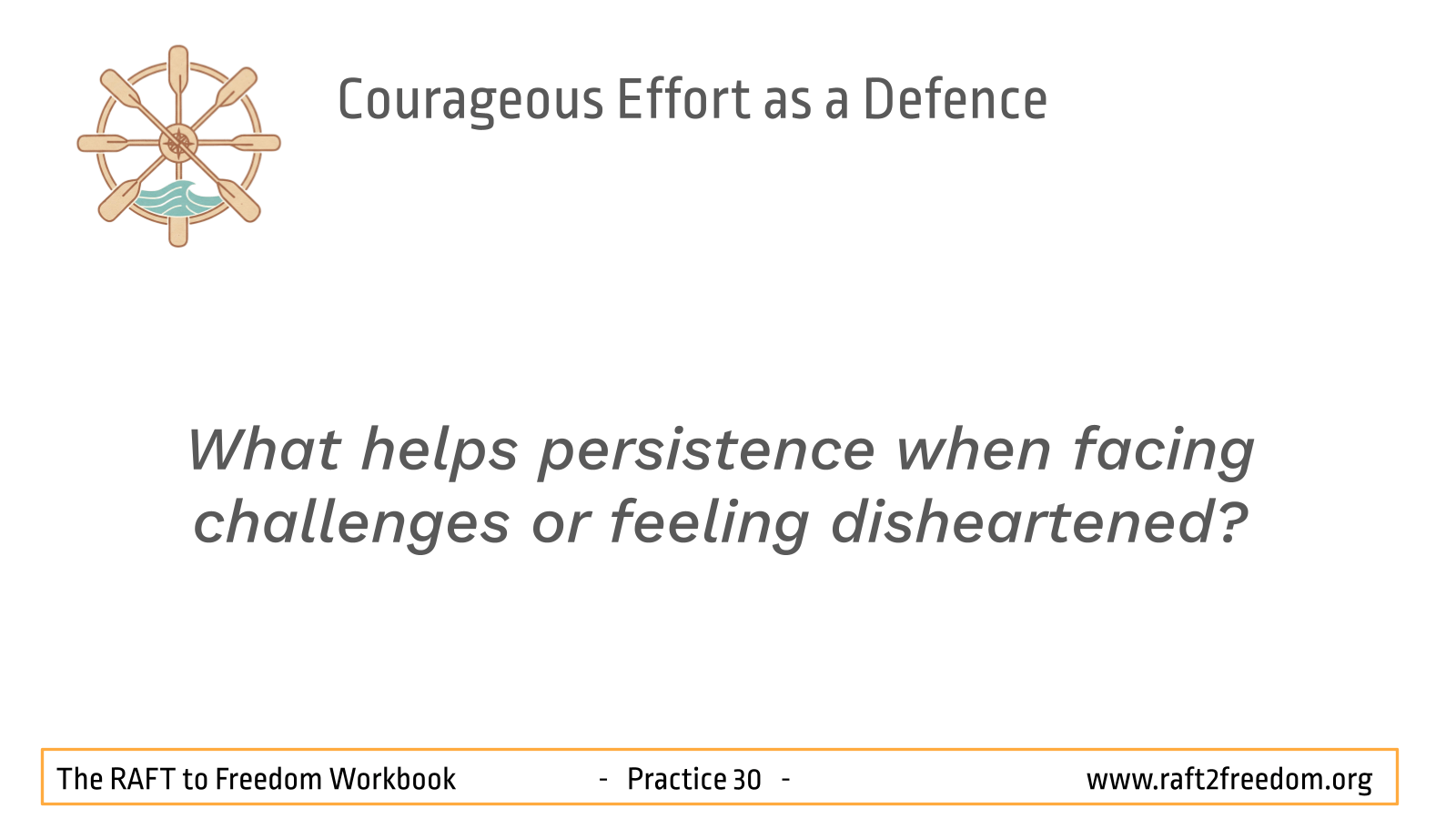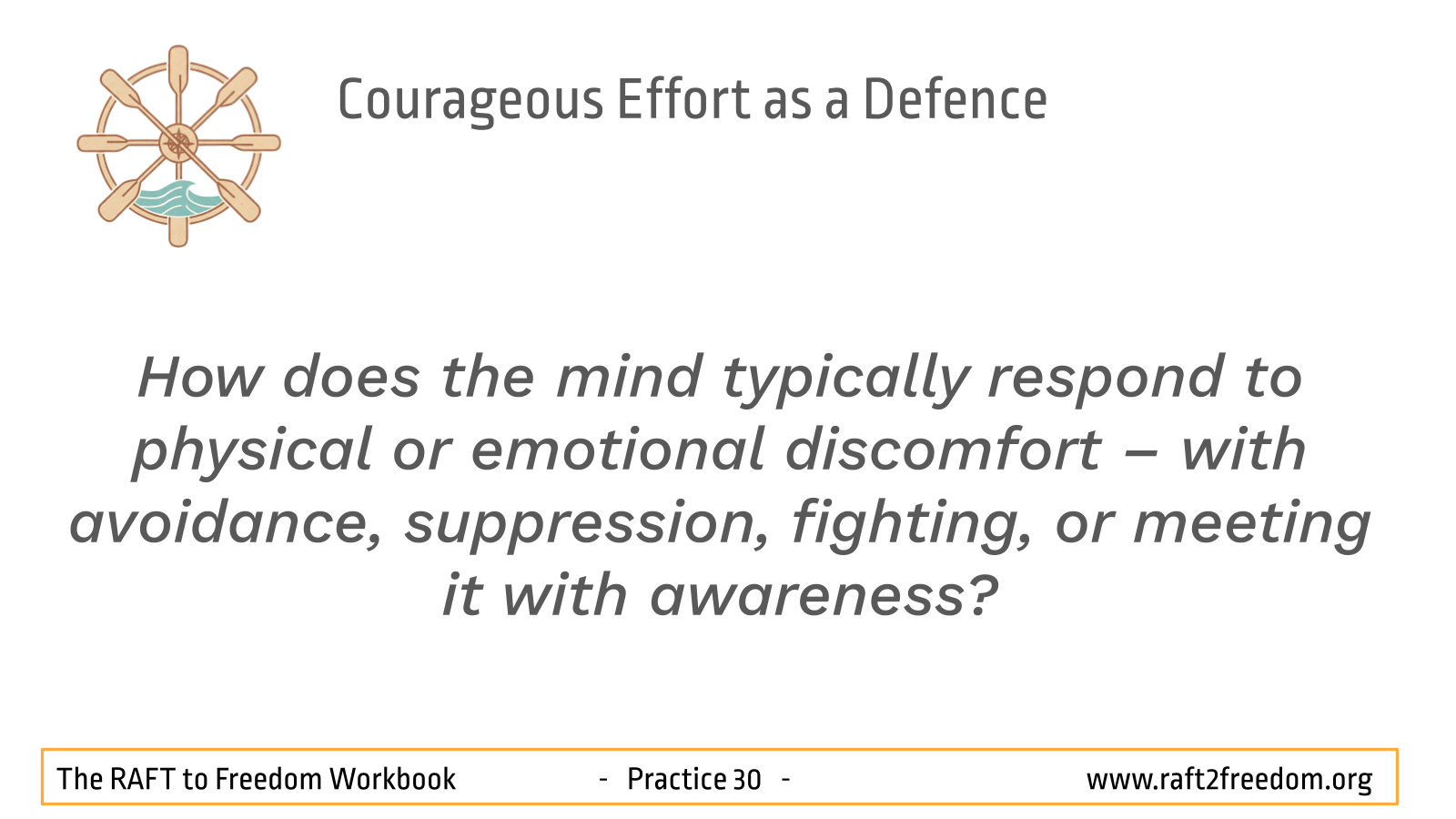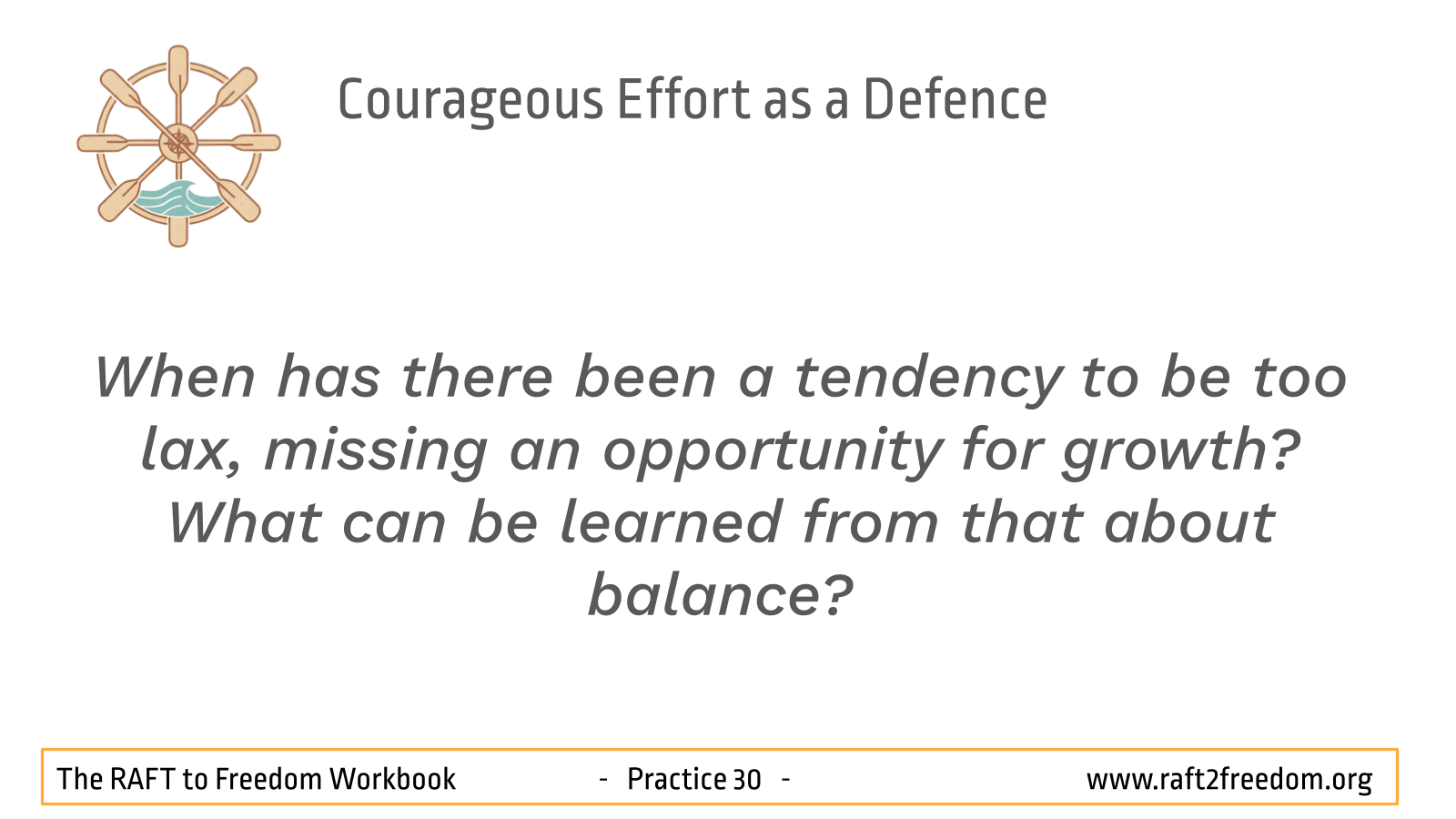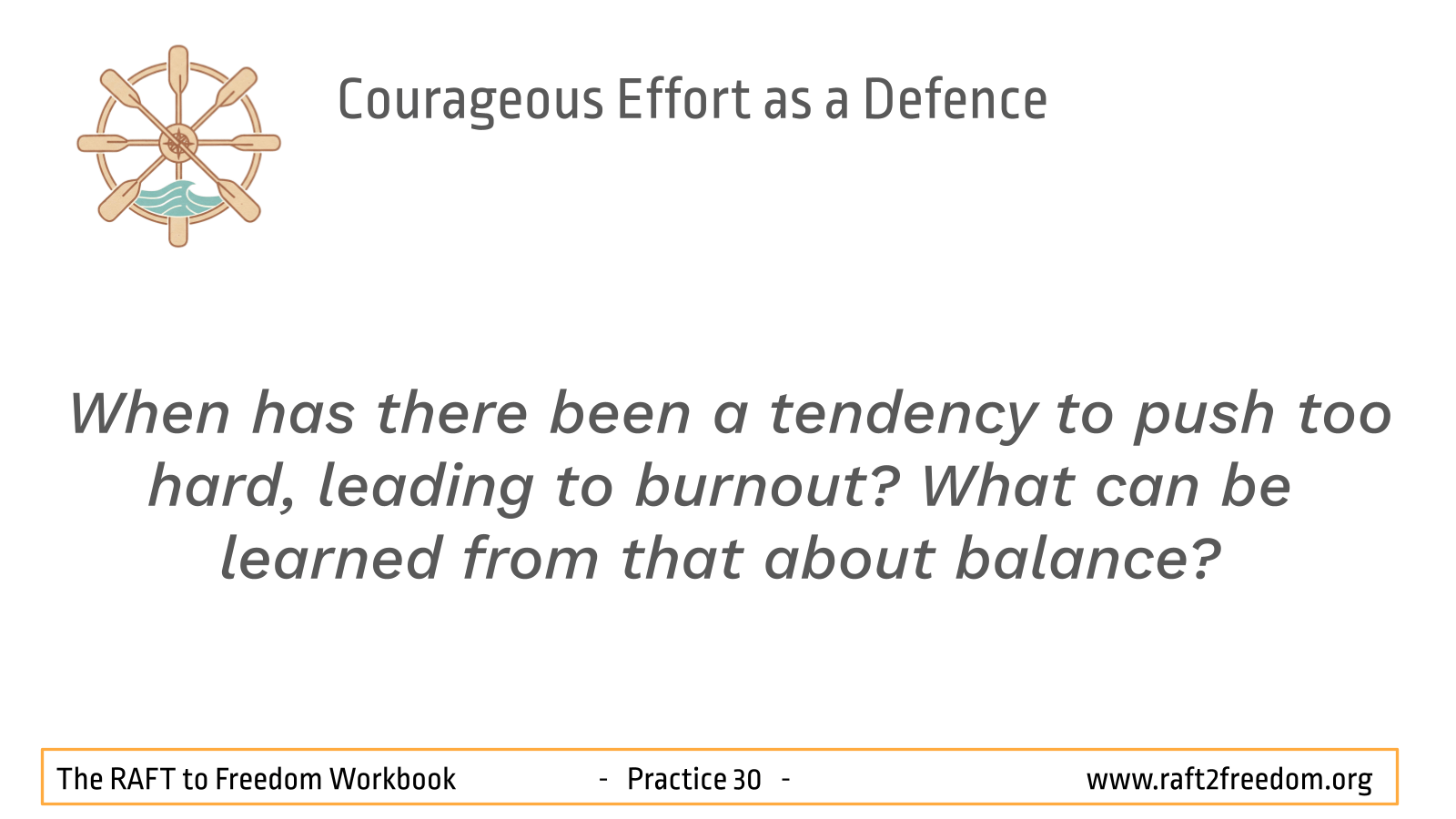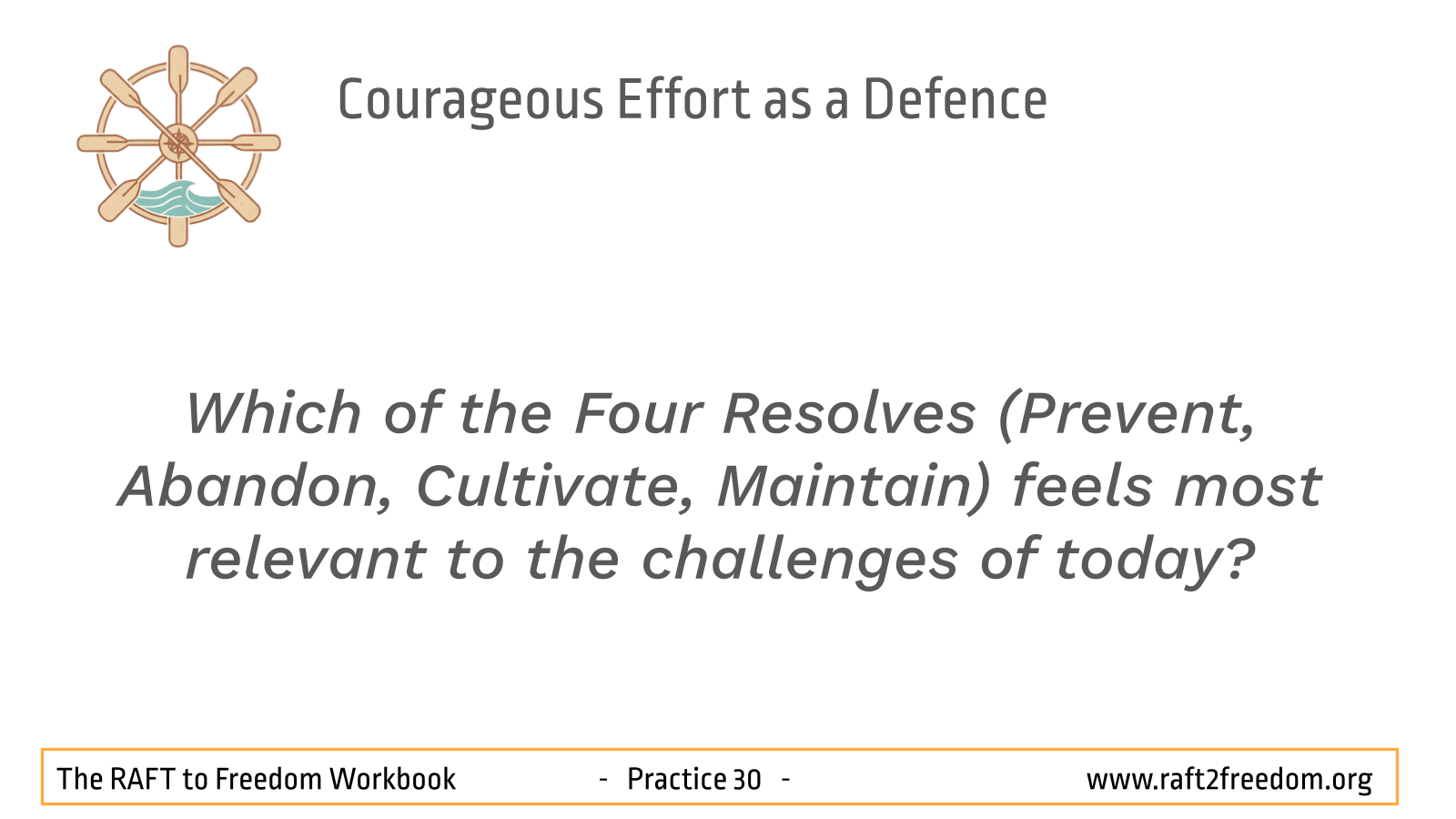Courageous Effort as a Defence
Fuelling the journey
Energy is the ally of wisdom. When energy is strong, mindfulness is sharp, and we see clearly what to do.
Inspired by Gotama (the Buddha)
Courage is resistance to fear, mastery of fear, not absence of fear.
~ Mark Twain

Episode 30: Courageous Effort as a Defence
An AI generated ‘deep dive’ into this aspect of the RAFT to Freedom
Following Confidence as a Defender of Freedom, the inspiring foundation, we now engage the Second Defender – Courageous Effort (Viriya). This is the vital, energetic force required for the challenging work of the second stage of our journey – ‘Abandoning’ harmful cravings and compulsions. If Confidence gives us the trust to begin, Courageous Effort provides the sustained energy and determination to persist on the path, transforming intention into reality.
In the RAFT to Freedom metaphor, where we are the captain, navigator, and crew, Courageous Effort is the skilful energy and the consistent power output propelling our raft. It is the persistent paddling needed to make headway against the strong currents of craving and the inertia of old habits. Without it, the raft drifts aimlessly; with it, steady headway is made across the unpredictable currents of craving, avoidance and confusion. Courageous Effort ensures the raft, launched with Confidence, actually moves towards the safe shore.
This quality in all of its’ flavours – energy, effort, courage, resolve and application – is so foundational that it appears nine times across Gotama’s ‘37 Liberating Practices’: the ‘Five Defenders’ (faculties and powers), the ‘Seven Supports of Awakening’, the ‘Four Superpowers’, and crucially, as ‘Appropriate Application’ within the Middleway. Its indispensable role is underscored by Gotama’s reference to his path as ‘Viriyavada – a teaching of effort’. This effort, however, is not about harsh self-discipline or aggressive striving. It is the engine that drives the entire journey.
The many dimensions of Courageous Effort: from foundational resolve to refined superpower
Courageous Effort is a central defender on the path to freedom. However, it is not a simple, one-dimensional quality. Its repeated appearance throughout the 37 Liberating Practices is a deliberate teaching that reveals a sophisticated developmental path. Understanding these distinctions allows us to apply our energy with greater wisdom and precision at every stage of our journey.
The Pali word viriya manifests in different ways depending on the context, developing from a foundational resolve into a subtle and powerful skill. This refined skill is precisely what we explored on the ‘Island of Superpowers’, where Courageous Energy provides the engine for our journey.
This progression can be understood as an evolution in four key stages:
- The Four Resolves as the foundational blueprint: The most practical and fundamental expression of Courageous Effort is the very framework of the ‘Four Resolves’ that we explored in Chapters 15 through 19. The RAFT to freedom metaphor of Recognising, Abandoning, Freedom, and Train serves as the operational definition for all skillful effort. This is the constant, underlying activity that clarifies the mind and lays the groundwork for all further progress. Whenever the path calls for ‘effort’, the underlying mechanics are always this dynamic, four-part process.
The Four Resolves, also known as the Four Right Efforts provide a clear guide for how to apply energy skilfully. They are not four separate energies but four wise ways to direct the single power of courageous effort.
| Resolve | The Work | RAFT Metaphor Analogy |
| Prevent | Guarding against unhelpful states before they arise. | Steering clear of known reefs and hazards. Avoiding triggers; recognising and stepping back from high-risk situations before craving takes hold. |
| Abandon | Letting go of unhelpful states that have arisen. | Bailing water from the raft and patching the holes. Applying mindfulness and other tools to let go of craving, resentment, or fear once they are present. |
| Cultivate | Nurturing helpful states that have not yet arisen. | Gathering new, sturdy materials for the journey. Intentionally fostering qualities like kindness, patience, and generosity through practice and action. |
| Maintain | Sustaining helpful states that are already present. | Diligently maintaining the raft and its course. Sustaining moments of calm, clarity, or compassion, allowing them to deepen and stabilise. |
- The Four Superpowers as the engine for sustained action: Effort here is applied with greater precision as one of the Four Superpowers. It becomes the finely-tuned engine that transforms resolve from intentions to sustained actions. The Four Superpowers – Noble Desire, Courageous Energy, The Heart’s Compass, and Fearless Investigation – provide the energy, focus, motivation, and wisdom necessary to transform struggles and successfully navigate towards freedom.
- The Five Defenders – from potential to unshakeable strength: The path then turns inward, focusing on cultivating effort as an internal quality. Initially, it appears as a ‘Faculty’. At this stage, it is a developing skill that must be carefully nurtured and balanced. As we discussed in Chapter 22 with the simile of the lute, too much effort leads to agitation, while too little leads to apathy. This is the active process of learning to apply balanced energy. Through consistent practice, this managed faculty matures into an unshakeable ‘Strength’ or ‘Power’. Here, energy is no longer a quality we must consciously manage against laziness, but becomes an intrinsic and indomitable spiritual stamina, impervious to its opposite. This chapter covers the transition of energy from a possibility (Faculty) to an embodied reality (Defender).
- The ‘Seven Supports’ – a catalyst for insight: In its most refined form, energy acts as one of the Seven Supports. Here, it becomes a responsive, tactical tool. As an energising support, it is intentionally cultivated in moments of mental dullness or lethargy to arouse the mind, inject passion into the practice, and create a bright, clear state of mind necessary for liberating insight to dawn. We will be exploring this later in chapters 43 and 46.
- ‘Appropriate Application’ of the Middle Way: The energy of the Middleway is the sixth factor of the eightfold path, which we are calling Appropriate Application, traditionally known as Right Effort, to be explored further in chapters 57 and 63. The Four Resolves outlined above, are the specific, practical definition of what Appropriate Application actually is. In short, the ‘energy’ of the Middleway – Appropriate Application – tells us that we must apply effort and the energy of the Four Resolves tells us how to apply it: prevent, abandon, cultivate and maintain.
This progression of ‘viryia’ shows that – energy, effort, courage, resolve and application – begins as the practical intention of the ‘Four Resolves’, is refined into a precision instrument – a true Superpower and is then internalised and strengthened from a faculty into an embodied Defender. It becomes a responsive, tactical Support and culminates as the positive feedback loop in the Middleway of ‘Appropriate Application’ – reinforcing the original intentions of the Four Resolves.
Courageous Effort as a Defender: from faculty to strength, training our energy
Courageous effort begins as an innate capacity, a faculty one possesses. Through consistent, mindful application, it matures into an unshakable strength. As Gotama suggested, just as a carpenter skilfully works with wood, transforming rough timber into a finished beam through repeated strokes, so too is energy cultivated until it becomes a dependable strength. As a Defender, this strength supports the difficult work of abandoning harmful compulsive and reactive behaviours and sustains the cultivation of healthier patterns.
Why Courageous Effort is vital for ‘Abandoning’
- Abandoning harmful compulsions: Abandoning harmful compulsions requires a heroic level of energy and persistence. The gravitational pull of old habits is immense, and the path to freedom is rarely a straight line. Courageous Effort is the quality that allows us to meet these challenges with resilience and determination.
- It counters lethargy and complacency: The mind’s tendency is often towards the familiar and the easy, even when it’s harmful. Courageous Effort is the antidote to this inertia. It’s the energy that gets us to the meditation cushion, to a support meeting, or to choose a healthy coping mechanism over a harmful one.
- It provides resilience in the face of setbacks: Lapses and difficulties are sometimes part of the journey. Courageous Effort is the inner strength that allows us to get back up after a fall. It transforms setbacks from failures into learning opportunities, fostering a spirit of recommitment rather than collapse. The simile of tuning the lute is key here: effort must be balanced – not so tight that it snaps with frustration, nor so loose that it produces no result.
- It fuels the other Defenders: Within the Five Defenders, Courageous Effort is inseparable from the others. They work as a team:
- Confidence inspires Effort.
- Effort fuels mindfulness.
- Mindfulness steadies a Gathered Mind.
- A Gathered Mind supports Discernment.
- Discernment, in turn, strengthens Confidence.
Mindful effort leads to effortless mindfulness
Vince Cullen
Effort is the dynamic link that energises this entire system, making the raft not just a vessel but a powerful vehicle for transformation.
Manifestations of Courageous Effort on the journey to freedom
Courageous Effort is not an abstract idea; it manifests in small, consistent actions every day. It is the quiet resolve to:
- Engage with your path:
- Show up: Simply facing the world without old patterns of escape can take enormous courage. Sometimes, just showing up for another day is an act of courage.
- Ask for help: Admitting a struggle or a problem and asking for support is a foundational act of Courageous Effort.
- Learn from setbacks: Viewing lapses not as failures but as learning opportunities, and recommitting with determination rather than collapsing into shame.
- Working with inner experience:
- Face difficult emotions: The willingness to honestly look at underlying pain, discomfort, or strong urges without amplifying or suppressing them.
- Deal with reactivity: It takes courage to let a reactive feeling be, without adding fuel to the fire with stories or justifications. Taking three breaths before reacting is Courageous Effort.
- Question thoughts: Having the courage to ask, “Does this thought need to be believed right now?” can interrupt a powerful pattern. “Mara – I see you!”
- Building a supportive Life:
- Practise conscious abstinence: Making the moment-to-moment effort to choose freedom, especially when facing triggers or urges.
- Cultivate healthy routines: Putting energy into establishing supportive habits such as meditation, exercise, sleep, nutrition, and connection.
- Help others: Applying personal experience to support others, which also strengthens one’s own resolve.
How to strengthen Courageous Effort
Courageous Effort is not about brute force or gritting your teeth. It is a wise and sustainable energy. Here are ways we can cultivate it:
- Connect with inspiration: Regularly remind yourself why you are on this path. Connect with stories of others who have found freedom, read inspiring texts, or reflect on the moments of clarity and peace you have already experienced. Confidence is the fuel for effort.
- Start small: Overwhelming yourself with huge goals can drain energy. Focus on small, manageable steps. The goal might be to meditate for just five minutes, to pause for one mindful breath before reacting, or to make one healthy choice today. Each small victory builds momentum and strengthens the muscle of effort.
- Balance effort: Remember the simile of the lute. Is your effort tense and strained? Or is it lax and unfocused? Find the middle path. Ask: ‘Is this effort creating tension and stress (too tight), or is it leading to complacency (too loose)?’ The aim is a feeling of steady, sustainable engagement. The effort should feel energising, not depleting.
- Celebrate the effort, not just the outcome: Acknowledge and appreciate the act of trying, regardless of the result. The victory is in showing up, in making the wholesome choice, in turning the mind towards freedom one more time. This internal encouragement refuels your determination.
- Rest wisely: Courageous Effort is not tireless. It requires periods of rest and rejuvenation. Wise rest is not collapsing into distraction but consciously allowing the body and mind to recharge. This could be through deep relaxation, spending time in nature, or engaging in wholesome, restorative activities.
Self-reflections
Take a few moments for honest self-inquiry, approaching these questions with a caring and curious mind:
- Is energy in this moment fuelling freedom or feeding habit?
- Which of the Four Resolves (Prevent, Abandon, Cultivate, Maintain) feels most relevant to the challenges of today?
- When has there been a tendency to push too hard, leading to burnout? What can be learned from that about balance?
- When has there been a tendency to be too lax, missing an opportunity for growth? What can be learned from that about balance?
- How does the mind typically respond to physical or emotional discomfort – with avoidance, suppression, fighting, or meeting it with awareness?
- What helps persistence when facing challenges or feeling disheartened?
- How can kindness and adjusted expectations be applied when energy is naturally low?
Journaling prompts
Use a journal to explore these themes further:
- The ‘why’ of the journey: Write down the deepest reasons for being on this path. What does a life of well-being and freedom truly mean, in vivid detail? When energy wanes, this ‘why’ is the fuel.
- Energy audit: For one day, track what activities, interactions, and thoughts generate energy versus which ones drain it. At the end of the day, reflect on the patterns. How could effort be placed more wisely tomorrow?
- The Lute String: Describe a situation where effort was ‘too tight’ (anxious, striving) and one where it was ‘too loose’ (complacent, passive). What did each extreme feel like in the body and mind? What would a ‘well-tuned’ effort have felt like?
- Learning from setbacks: Describe a recent setback not as a failure but as feedback. How can this valuable information inform the efforts of tomorrow?
- Celebrating a small win: Describe a recent moment, no matter how small, where one of the Four Intentions was successfully applied. Honour that success in detail.
- A dialogue with resistance: When resistance or inertia is felt, imagine it as a character. Write a short, compassionate dialogue with it. What is it afraid of? What does it need to feel safe enough to allow forward movement?
- Daily intentions: Each morning, write down the day’s intention for courageous effort. In the evening, reflect: how was energy directed? Did it serve freedom or habit?
Supporting material: scientific and philosophical perspectives
For those interested in the scientific and philosophical underpinnings of Courageous Effort as a Defender, the following overview highlights some key connections.
- Neuroscience: From a neurological perspective, courageous effort can be understood as the engagement of the prefrontal cortex (PFC) to regulate the limbic system. The PFC, the brain’s executive centre, allows for conscious choice and overrides the impulsive, habit-driven urges originating from deeper brain regions. Every time Courageous Effort is applied to pause, reflect, and choose a skilful response over an automatic reaction, the neural pathways of self-regulation are strengthened. This is neuroplasticity in action: the brain is literally being rewired for Freedom.
- Psychology: In psychology, Courageous Effort aligns with concepts like self-efficacy and grit. Self-efficacy is the belief in one’s ability to succeed, which is built through repeated, successful efforts. Grit, as defined by Angela Duckworth, is the combination of passion and perseverance toward long-term goals. This aligns with therapies like Behavioural Activation, which demonstrates that initiating positive action, even when motivation is low, is a powerful way to counter apathy and build momentum.
- Philosophy: Virtue traditions across cultures prize courage and persistence. Stoic philosophy resonates deeply with the Buddhist concept of Courageous Effort, teaching the importance of focusing energy on what is within control (thoughts, judgements, and actions) and accepting what is not. This requires a courageous and persistent effort to maintain inner equanimity regardless of external circumstances, a principle central to navigating the challenges on the journey to liberation.
Remember to remember
Courageous Effort is the engine of the raft, the persistent energy that transforms the aspiration for ‘Freedom’ into a lived reality. It is not about forcing outcomes but about showing up with steady determination for the journey itself. This quality first manifests as the Four Resolves – the disciplined, moment-to-moment work of steering the raft away from dangerous currents and towards the safe harbour of liberation.
As the journey continues, this effort matures from a conscious act of will into an intrinsic, unshakable spiritual stamina. It becomes a balanced and wise energy, perfectly tuned like a lute string – neither too tight with striving nor too loose with complacency. This refined energy fuels mindfulness, sharpens discernment, and works in concert with all the other Five Defenders of Freedom. It is the heroic heart of the practice, the quiet courage that takes the next wise step, again and again. Every small act of effort is fuel for the raft. Each time one persists, one affirms: “I choose freedom.”
By effort, vigilance, restraint and self-control, let the wise one make for themselves an island which no flood can overwhelm.
Gotama
Courage is not the absence of fear, but the triumph over it.
Nelson Mandela
Sutta references
- Indriya-vibhanga Sutta (SN 48.10) – The analysis of the faculties
- Summary: Defines Viriya (energy/effort) as one of the Five Faculties leading to liberation. It is the energy exerted for abandoning the unskilful and cultivating the skilful. This establishes effort as a fundamental spiritual capacity that can be cultivated into an unshakable power.
- Sammappadhāna Sutta (AN 4.13) – Right Effort
- Summary: Outlines the Four Right Efforts—preventing, abandoning, cultivating, and maintaining. This provides the canonical and practical framework for applying effort in daily life and practice.
- Sona Sutta (AN 6.55) – The simile of the lute
- Summary: Advises balancing energy like tuning a lute: not too tight, not too loose. This teaches the importance of sustainable, balanced, and wise effort, avoiding the extremes of burnout and complacency.
- Saṁyutta Nikāya 48.9 – The carpenter simile
- Summary: Compares the gradual development and refinement of the faculty of energy to a skilled carpenter shaping wood. This illustrates how repeated practice refines and strengthens Courageous Effort.
| RAFT to Freedom © 2025 by Dr Cathryn Jacob and Vince Cullen is licensed under Creative CommonsAttribution-NonCommercial-ShareAlike 4.0 International. |
